Art South Africa Volume 6: Issue 01
Nelson Makamo; Nyaniso Lindi; Colleen Alborough
VOICES OF THE FAMILY
NELSON MAKAMO SPEAKS WITH ROBYN SASSEN ABOUT HOW THE WISDOM OF HIS GRANDFATHER UNDERLIES HIS ART MAKING, WHICH RECENTLY CAUGHT THE EYE OF ITALIAN COLLECTORS.
At heart a painter, Nelson Makamo became associated with the Artists’ Proof Studio (APS) in Newtown, Johannesburg, in order to gain a sense of visual currency in the art world. Allowing his painterly enthusiasm to be invested in the realities and unpredictable possibilities of monotype, Makamo has also developed a specialisation for drawings in mixed media. “I never fear anything new”, he says.
Makamo has recently returned from a trip to Italy where his work achieved an unprecedented popularity amongst new collectors. He was one of three artists selected to represent the country in a newly formed cultural exchange programme between businesses in South Africa and Italy. The experience bolstered his enthusiasmHis courage continues to be bumped up by the support he has garnered from an art-buying community: “If one person is willing to spend money on my work, it gives me courage and energy to continue expressing myself freely.”
The artist describes himself as a storyteller. He works with the idea of a visual diary and his sketchpad is his constant companion. His quick gestural drawings are reminiscent of the work of Gerard Sekoto, while his astute handling of line, tone and composition, as well as the implicit stories underlying his work further recalls William Kentridge. Aside from Kentridge, the legacy of artists like Sam Nhlengethwa, Deborah Bell, Colbert Mashile and Sandile Zulu nurtures him. Politics and religion are important cornerstones in his life and work. With family roots that draw both from Christianity and ancestor worship, Makamo believes in art but draws from the values of both these religious ideologies.
“We are all moving in different directions,” says this brighteyed 25-year-old. Makamo acknowledges that there has been much disappointment in the political development of this country since democracy, but that these issues need representation. Having been feted internationally, and still reeling from the “Wow!” experience of being in Italy, he nonetheless still believes “there is no place like home. South Africa made me who I am. This is my home.”
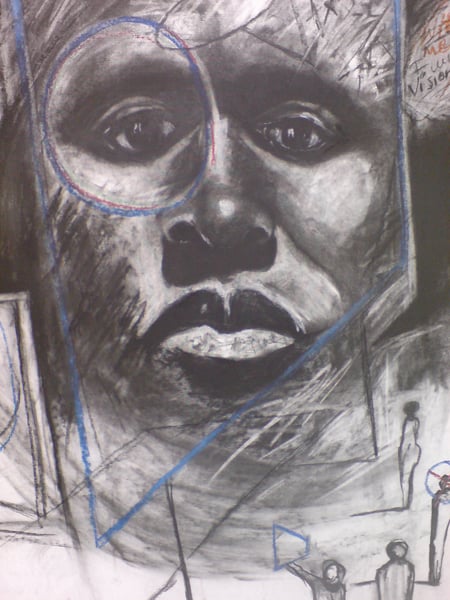 Nelson Makamo, from Art South Africa archives.
Nelson Makamo, from Art South Africa archives.
Family wisdom is particularly marked in his narrative. For an APS project titled Ubuntu Stories, undertaken in 2004, Makamo interviewed his grandfather.
“I knew that my grandfather was the person to talk to,” he revealed in a 2004 interview with Darnisa Amante. “He knows how to turn a boy into a man.”
“Many people are caught between the mistakes of the past and the possible calamities of tomorrow,” Makamo was told by his grandfather. “I was brought up by respect and caring, and also to transfer that to my children, who were brought up with love and respect and caring… If there can be love, respect to us, the elders, and pass that on to children, the future will be full of dynamic opportunity, and every child will be proud to be part of this universe.”
He quotes his grandfather in acknowledging the respectless decay into which our world seems to be shrinking. “We had enough of the past… are we still going to build a nation to erect a new civilization which can lay claim to its existence because it is humane? If there can be love, respect to the elders that is passed on to the children, the future will be full of dynamic opportunity”.
Maybe these values are overly optimistic, mawkish pollyannaisms even in the cut and thrust of the difficult and money-driven art world – or , but maybe not. Perhaps Makamo fits into a dated paradigm in his direct and honest engagement with the urban world which surrounds him. He is however not trying to make superficial gestures of technological slickness in his approach, nor for that matter is and he’s also nothe trying to make self-consciously deep ones eithergestures. He speaks and makes art from the heart, choosing charcoal as his primary medium.
Robyn Sassen is a freelance arts writer and contributing arts editor for the SA Jewish Report.
About Nelson Makamo: Growing up in the Limpopo Province town of Modimolle (previously Nylstroom), Makamo first emerged on the art scene when he participated in a municipal art exhibition. A grade 12 learner at the time, he was the youngest participant. He moved to Johannesburg in 2003 with the desire to study fine art but was dissuaded by financial circumstances. A resident of Tembisa, he won a bursary at the Artists’ Proof Studio, where he studied for three years. He has remained affiliated with the studio, under the sponsorship of Pinpoint One Human Resources. Makamo hosted a sell-out solo exhibition at Obert Contemporary in Melrose Arch in 2005.
A WHEEL IN MOTION
NYANISO LINDI IS A VERSATILE PRINTMAKER WHOSE REPERTOIRE EMBRACES SUBTRACTIVE COLOUR RELIEF, COLLAGES AND FORAYS INTO MULTIMEDIA, WRITES ROBYN SASSEN.
“The past defines me”, says 33-year-old artist Nyaniso Lindi. Like artist Vincent Baloyi, associated with Rorke’s Drift, yet for many years employed by Wits University’s Fine Art Department in a menial capacity, Lindi has an unglamorous day job. For the past four years, he has worked as a cleaner and studio assistant in the Graphics Section of the Fine Arts Department at Rhodes University. Perks include engagement with the students and access to the finest printmaking equipment in the country.
The Fine Line Press is the country’s only professional print studio in an academic institution. Dominic Thorburn, who initiated Fine Line and heads the Fine Arts Department’s Graphics Section, recognised Lindi’s talent and circumstances. Thorburn facilitated a shift in his job description, enabling Lindi to learn the ropes of printmaking, thus elevating him from being a cleaner, and giving him insight into the linked printmaking techniques, from silkscreen to lino, etching to lithography.
The challenge is great for an artist defined by a grim and oppressive history to also have to economically wade through its detritus, particularly while watching privileged students skim through degree expectations and move on. While various individuals have been responsible for mentoring Lindi throughout his career, the bulk of the passion to make art of personal relevance has had to constantly come from within.
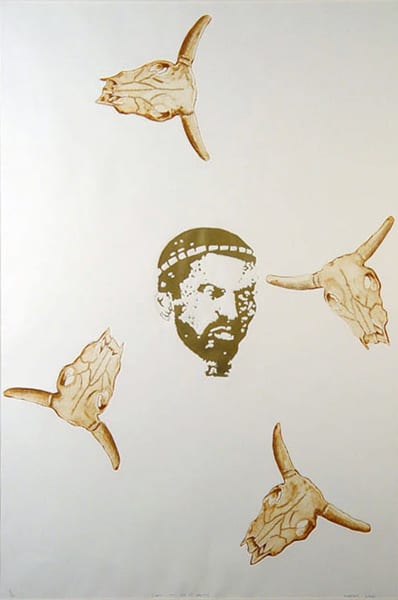 Nyaniso Lindi, from Art South Africa archives.
Nyaniso Lindi, from Art South Africa archives.
Printmaking became his professional medium in 2000 when he joined Dakawa, a community outreach project formed as a spin-off to an African National Congress settlement established between 1982 and 1992 in Tanzania for artists in exile. In Grahamstown, Giselle Baillie ran Dakawa. The centre specialised in relief printmaking. “Although painting was my strong point, Dakawa enabled me to be exposed to printmaking for the very first time,” says Lindi.
eGazini, mooted in 2000 by Baillie and Thorburn, was another step in Lindi’s printmaking career. Initially begun as a print portfolio, eGazini aimed to establish a “fresh sense of community identity”, according to another participant, historian Julia Wells. The project aimed to expose close to 30 local artists to the racially laden history of the Battle of Grahamstown and then facilitate the production of a personal interpretation of this history in printmaking. Meaning “place of blood”, eGazini explored many traditional and historical narratives. It achieved international acclaim and developed a momentum: eGgazini blossomed into a self-sufficient community outreach project in Joza, a Grahamstown township.
Lindi has developed since his first exposure under eGazini’s impetus. His experimental repertoire embraces subtractive colour relief, collages of found objects, as well as forays into multimedia, where he brings his etchings to animated digital life – one of these works saw Lindi nominated as a finalist for this year’s ABSA L’Atelier.
Lindi believes that it is no longer fashionable to face historical trauma, but he is adamant in his belief in the power of art as educational tool and instrument of protest. His attitude recalls the illicit prints made in improvised print shops; it speaks of creative protest where work with value is based not on the financial wherewithal of the artist, but his skills, talent and work ethic. The wheel does turn, no matter how slowly it might seem to.
Robyn Sassen is a freelance arts writer and contributing arts editor for the SA Jewish Report.
About Nyaniso Lindi: Born in 1973 in the Fingo Village, Lindi lives in Grahamstown. After a school career distinguished by various art prizes, Lindi was taken under the wing of the then Head of Department of Rhodes University, Professor Robert Brooke, who assisted him in getting enrolled to do the Fine Art degree in 1995. Academic and language difficulties prevented him from graduating; in 1998 he enrolled in the Cape Town Film and Television School. He is currently registered for his Bachelor of Fine Arts degree at Rhodes University on a part time basis, and assists artists in printing their work, including Christine Dixie, Roxandra Dardagan Britz and Zola Toyi.
HAUNTED TERRITORY
COLLEEN ALBOROUGH BALANCES SUBJECTIVE ARTISTIC EXPRESSION WHILE STILL ENGAGING THE VIEWER IN AN EMOTIONAL AND PHYSICAL MANNER, WRITES CATHERINE GREEN.
 Colleen Alborough, Before the Time (detail), mixed media, 2007.
Colleen Alborough, Before the Time (detail), mixed media, 2007. It was perhaps fitting to encounter Colleen Alborough, a digital artist, through the technological form of email correspondence. However, what became apparent in learning about her work and process is that technology is only one tool in this Johannesburg artist’s varied media palette. Alborough’s work personifies her broad range of activities and interests. “I work in a variety of mediums, focusing on multimedia installations” she writes in a recent artist statement. “I am very interested in creating experiential installations, that encourage the viewer to explore and interact with the work in order to complete the narrative of the installation.”
To master the digital medium is a perilous task. Generally, work of this nature is poorly conceptualised and gallery’s struggle with its presentation. This in turn deadens its reception and discourages interaction. Given that art is a sensory activity that involves more than just sight, the challenge for the digital artist is to create an environment that allows the powerful undercurrents of their work to be realised. Alborough has tackled these issues with a sophisticated awareness, employing a diversity of expression.
Alborough’s recent exhibition at the Premises Gallery was a rigorously conceptualised body of work. Nocturnal states of mind, ambivalent and shifting in tone, formed the conceptual framework for the exhibition. The exhibition included her interactive video installation Night Journey (2005–present), an immersive and emotive environment. Previously exhibited in earlier iterations at Johannesburg’s Substation and Durban’s KZNSA galleries, it led the viewer through a darkened maze. Each turn triggered a sensor that played various recordings, night sounds that tapped into primal emotive states. The passage led to a small room where a bundled figure lay on a bed; gauze screens installed above the figure were used to project dreamy visuals with poetic narratives. Alborough further included live feed of viewers negotiating the maze into her animation sequence, embedding cameras into felt screens for the purpose. The result was a psychic space of dreams, nightmares and insomnia, a space that was both visceral and vague.
 Colleen Alborough, Night Journey, 2005 to present, mixed media installation – detail from version shown at The Premises Gallery,
Colleen Alborough, Night Journey, 2005 to present, mixed media installation – detail from version shown at The Premises Gallery,
June 2007.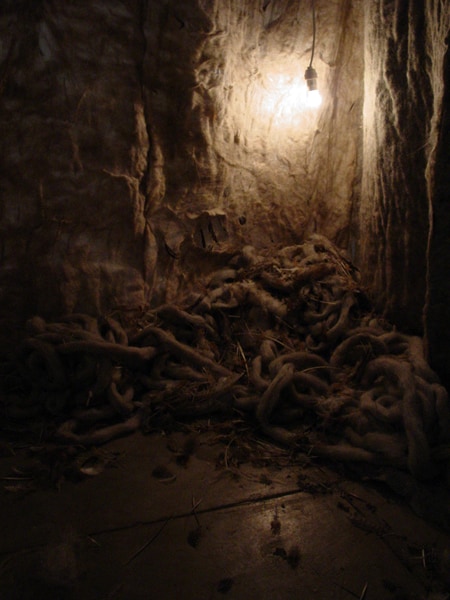
Experiencing the maze of Night Journey was an unsettling experience. It forces the viewer to engage with physical and psychological space. While the soft walls, littered debris of gauze, feathers and dull lighting created a womb-like environment that was comforting and restorative, the bodily texture of the installation also became repellent and foreign. The soundtrack of overlaid sounds, coupled with the typing of text on the screens was overwhelming, prompting psychological retreat. Similarly, the flicker of red alarm sensors and the image of oneself in the animation evoked a sense of vulnerability – it also cued South Africa’s pervasive security culture.
The tactile walls of Night Journey, a work that functions to release, disclose and acknowledge topical issues without becoming didactic, were composed of handmade felt, laboriously processed by the artist. This labour intensive approach is almost ritualistic, what Alborough terms “a rite of passage”, a contemplative birthing process through which the final work is realised. The medium retains traces of the emotional and physical intensity of the process that continues to build on the work’s meaning beyond the completion of the work. Generally, Alborough’s work stems from an introspective and intensely emotional creative process, which she views as “a form of psychic survival”. Her work process allows her to engage with her relationship to the creative, social and psychic space in which she lives.
“The art making process, to me, is incredibly important and where I believe the transformative powers of art lie,” she says.
Alborough’s choice of media, which has previously included photography and her distinctive concertina-style artist books, is determined by its ability to “communicate some form of human emotion”. Her skill emerges in the way she balances subjective artistic expression in a manner that still engages the viewer in an emotional and physical manner.
Catherine Green is an art historian and writer based in Johannesburg.
About Colleen Alborough: A digital multimedia artist based in Johannesburg, Alborough completed her BA (Fine Arts) with distinction at the University of the Witwatersrand, where she is currently completing a MA (Fine Arts). She has presented two solo exhibitions this year, an untitled solo show at The Premises Gallery and Before the Time at Pretoria’s Outlet gallery. Group shows include the drift between (2005), 6 on a scale of 1-10 (2002) Interart/Interact (2001). Alborough was one of four artists selected to participate on the KZNSA Gallery’s Young Artists Project in 2004.
 Nelson Makamo, from Art South Africa archives.
Nelson Makamo, from Art South Africa archives.
 Nyaniso Lindi, from Art South Africa archives.
Nyaniso Lindi, from Art South Africa archives.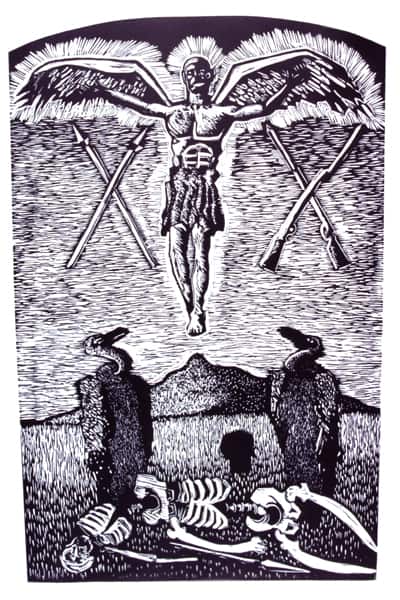
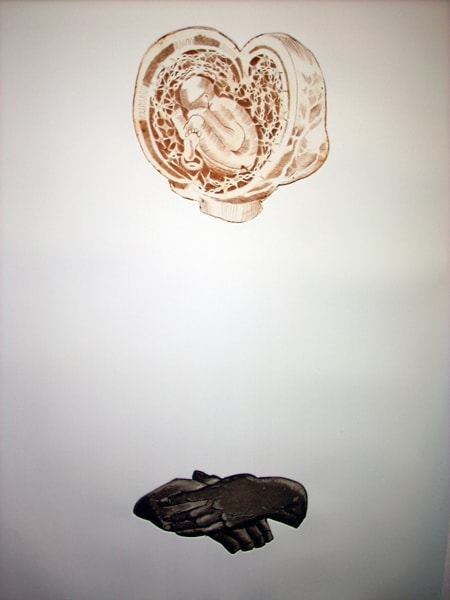
 Colleen Alborough, Before the Time (detail), mixed media, 2007.
Colleen Alborough, Before the Time (detail), mixed media, 2007.  Colleen Alborough, Night Journey, 2005 to present, mixed media installation – detail from version shown at The Premises Gallery,
Colleen Alborough, Night Journey, 2005 to present, mixed media installation – detail from version shown at The Premises Gallery,



